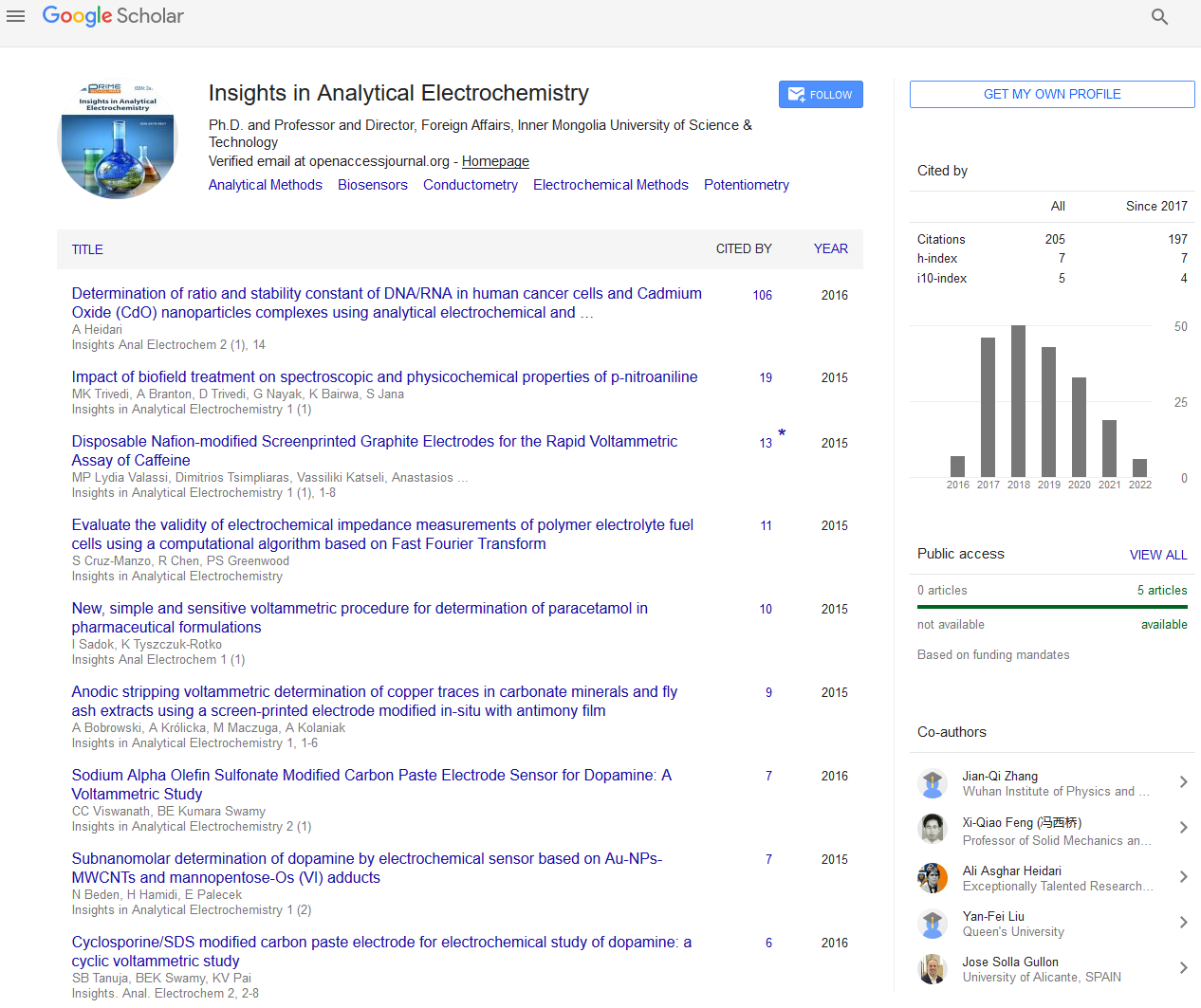Commentary - (2022) Volume 8, Issue 3
Organic Electrodes in Revealing Solid-State Electrochemistry
Alexander Vlad*
Department of Chemistry, Catholic University of Louvain, Belgium
*Correspondence:
Alexander Vlad, Department of Chemistry, Catholic University of Louvain,
Belgium,
Email:
Received: 02-May-2022, Manuscript No. ipaei -22- 13622;
Editor assigned: 04-May-2022, Pre QC No. ipaei -22- 13622 (PQ);
Reviewed: 18-May-2022, QC No. ipaei -22- 13622;
Revised: 23-May-2022, Manuscript No. ipaei -22- 13622 (R);
Published:
30-May-2022, DOI: 10.21767 / 2470-9867 - 8.3.11
Description
Natural terminal materials have arisen as expected contender
for electrochemical energy stockpiling applications with
profoundly alluring properties like normal overflow, maintainability,
and decreased ecological impression. The most recent
battery innovation depends vigorously on progress metal oxide
anode materials. Change metal oxide anode materials are obtained
after broad mining and costly manufactured conventions
like energy-escalated high temperature treatment. Moreover,
material expenses, taking care of, and reusing are driving endeavors
to foster natural anode materials. Late quick advances
in natural terminals can possibly prompt advancement advances,
not similarly as a simple option in contrast to conventional
progress metal oxide cathodes in customary optional batteries.
Is shown. Theoretically, most natural cathode materials work
with “n-type” or “p-type” redox charge aggregation. While
previous being concentrated on in their oxidized state (making
them appropriate just for the still immature lithium metal batteries),
the last option include counter anions for application
in dualion or anionic batteries. Current Liion cell gathering depends
on a Liion source cathode material (“ntype”) coupled to
a Liion have anode material (the recliner framework). Not at all
like the enormous variety of inorganic cathode materials, the
groundwork of the stateoftheart commonsense Organic LiIon
Cathodes (OLICs, all created throughout recent years as ntype)
was laid widely on enolate/carbonyl redox science. It is empowering
to see the headways in OLICs through electron withdrawing
subbed quinones, conciliatory metalmediated charge
delocalization, and stereoelectronic chameleonic impact, yet
they actually experience the ill effects of low limit and wasteful
redox energy. An ideal OLICs should have encompassing
steadiness, reversible multielectron redox, high hypothetical
limit and insolubility in Lireservoir state, which persuades us
to stretch the boundaries of natural science in the pursuit and
plan of new natural Liion redox dynamic materials. This has as
of late prompted the improvement of original formed sulfonamide
redox science with Li supplies and fantastic surrounding air stability.The redox capability of the sulfonamide cathodes is
equivalent with the best performing enolatebased ones; nonetheless,
lower limit passes on adequate space to address the
innate test of low energy thickness. To carry the current examination
accomplishments with OLICs nearer to genuine application,
it is profoundly requesting to investigate new redox
places past formed enolates and sulfonamides. In this work,
we show the primary use of formed oximates as sure terminal
materials. The oximate redox usefulness not just enhances
the group of natural cathode materials, yet additionally gives a
fantastic redox reversibility, low sub-atomic weight (high limit)
and high air stability of the anionic structure, satisfying the
prerequisite of OLICs as another possibility for Liion batteries.
To lay out the flexibility of the oximate redox science as sure
anode materials for Liion batteries, five lithiated oximate atoms
with various compound designs, including cyclic (sweet-smelling),
non-cyclic (nonaromatic), aliphatic and tetrafunctional
generalizations, are examined. The best performing competitor
(Li2BQDO) shows a high reversible limit of 357mAhg1 at a high
redox capability of 3V comparative with Li +/Rio, accomplishing
a particular energy thickness of over 1kWhKg1. Among the
remarkable properties of formed oximate, the most fascinating
highlights are in-situ intermolecular polymerization (azodioxy
coupling) and intramolecular floxane ring arrangement during
strong electrochemical redox responses. The great substance
and primary reversibility of the formed oximate concentrated
as well as the promising electrochemical execution highlight
the promising capability of this class of material as a positive
cathode material for lithium-particle batteries.
Acknowledgement
None.
Conflict of Interest
The author declares there is no conflict of interest in publishing
this article.
Citation: Vlad A (2022) Organic Electrodes in Revealing Solid-State Electrochemistry. Insights Anal Electrochem. 8:11
Copyright: ©Vlad A. This is an open-access article distributed under the terms of the Creative Commons Attribution License,
which permits unrestricted use, distribution, and reproduction in any medium, provided the original author and source are
credited.

